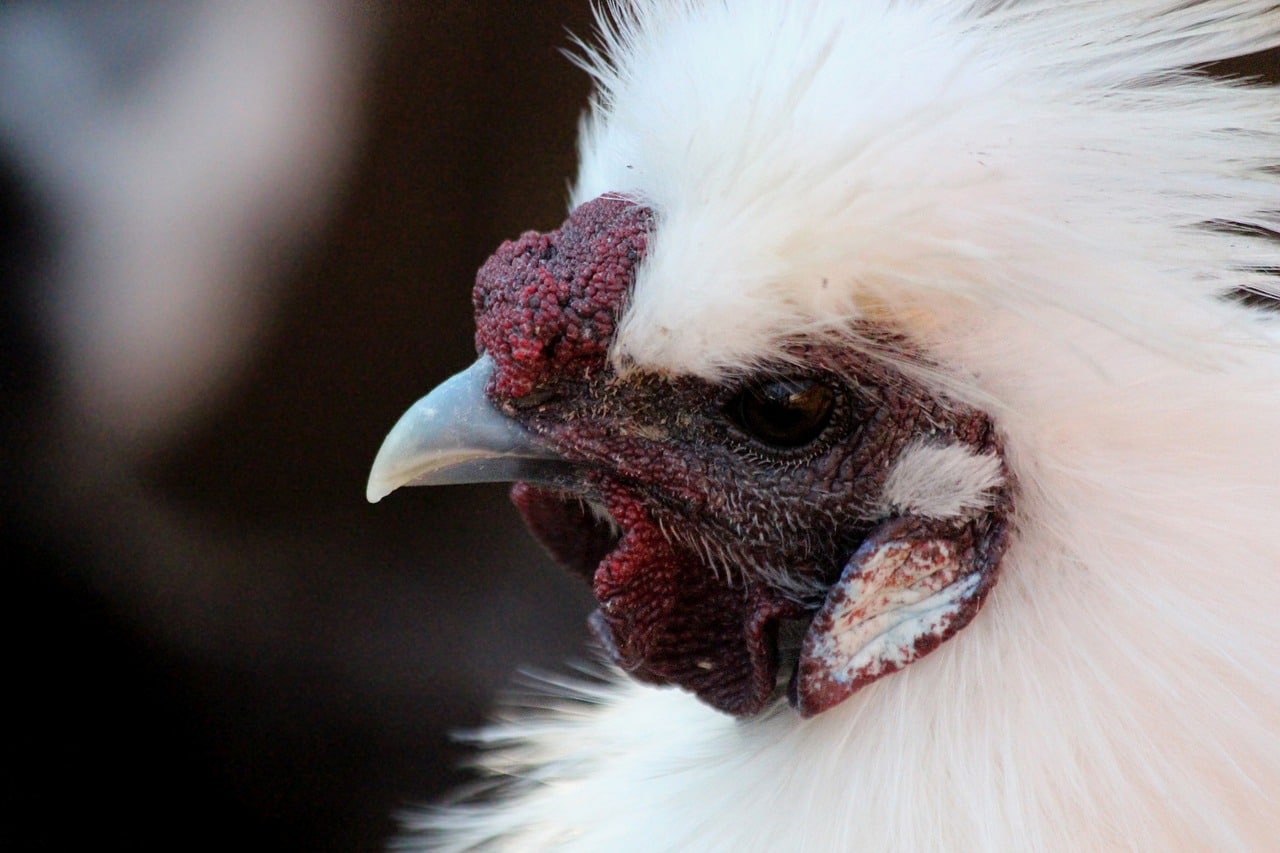They are fluffy, they are quirky, and they are definitely unique!
The Silkie chicken breed is one of the most bizarre breeds of chickens, offering backyard chicken keepers entertaining personalities, sweet temperaments, and gorgeous appearances to boot.
This breed is a stand-out in the chicken world for many reasons.
Although Silkie chickens differs greatly from other popular breeds, making it one of the less common breeds you can raise, it is a one-of-a-kind option that every homesteader should consider for their backyard flock.
[toc]
Silkie Chickens Overview
Here’s an overview of this breed’s characteristics so you can get an idea of what these birds are like before learning about the details.
| Lifespan | 7 to 9 years |
| Weight | 3 to 4 pounds |
| Appearance | Soft, fuzzy feathers of a variety of colors |
| Egg Color | Cream |
| Egg Production | 100 to 150 per year |
| Good for Beginners? | Yes |
| Minimum Coop Size | 4 square feet per bird |
| Price | $3 to $10 per chick, $15 to $50 per adult |
The Origin of Silkie Chickens
These bizarre-looking breed is believed to have come from Asia. It is unknown from where (or when), exactly, these breeds originated, but the most well-documented potential origin is ancient China.
A popular trade item on the Silk Road, the geography of the Silkie chicken lends itself naturally to the name of this breed.
That being said, the Silkie chicken can be traced back to other locations in Southeast Asia as well, such as Java and India.
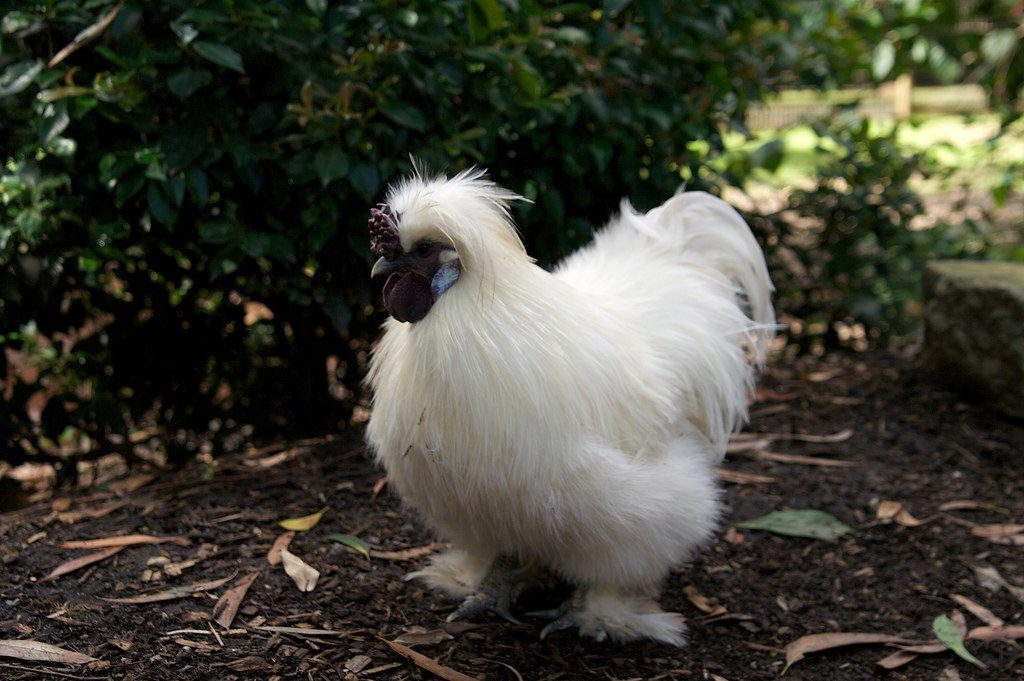
Marco Polo first wrote about a “furry chicken” breed in the recount of his 13th-century Asian travels, with the first naturalist account of the chicken published in 1598 by Ulisse Aldrovandi.
Silkies eventually traveled west on the Silk Road and reached North American soil shortly after via the maritime trade.
It was recognized officially in North America in 1874, rising to popularity quite rapidly in the States.
Due to its unique appearance, the Silkie chicken is surrounded by some interesting folklore.
For example, early Dutch breeders told consumers that the breed was the result of mating rabbis and chickens.
Popular in circus and carnival freak shows, these chickens were once believed to have actual mammalian fur, too.
Today, the Silkie chicken is one of the most ubiquitous and iconic breeds of chicken commonly kept on homesteads and family farms.
Usually kept as ornamental or pet chickens, they are also fantastic mothers and can be used to hatch the eggs of other chickens and poultry breeds.
Silkie Chicken Colors, Size, and Appearance
This section will explore everything you need to know about common colors, characteristics, and appearances of the Silkie chicken breed.
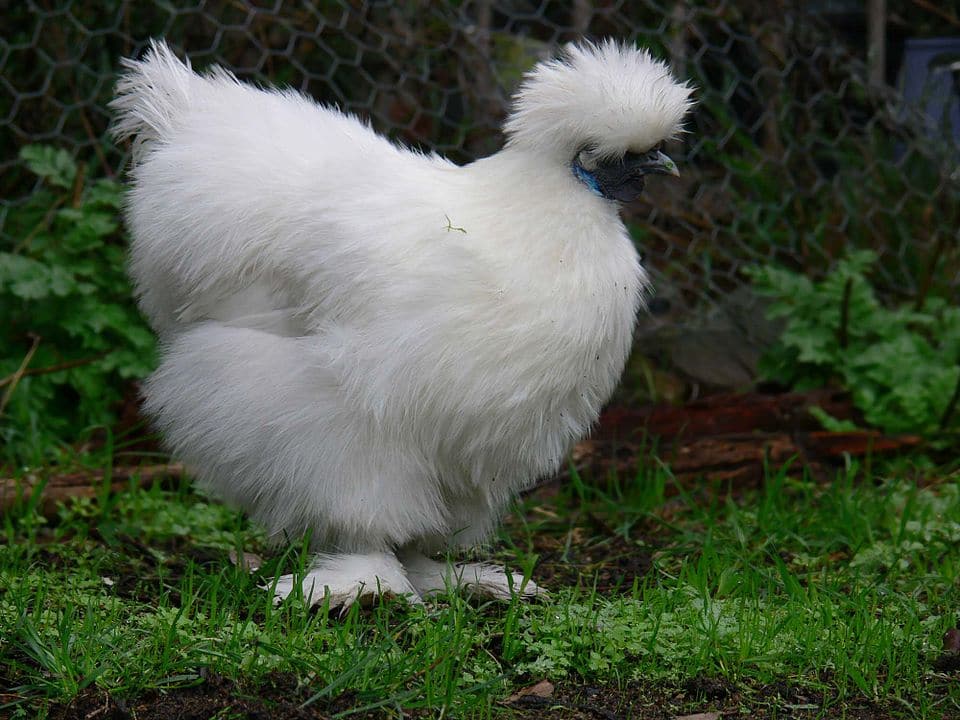
Size
Most Silkie chickens available for purchase or hatching in North America are bantam Silkies. This means that they are miniature versions of standard-sized chickens.
Usually, a Silkie bantam will weigh about half the normal weight of a typical chicken, and their eggs will be about a third smaller than normal eggs.
You can find standard-sized Silkies in Europe and other locations, but unfortunately, they just aren’t commonplace in the States quite yet.
Generally, Silkies found in North America only grow to about eight to fourteen inches tall and will weigh around three to four pounds at most.
Silkies tend to be fairly compact with short, squat legs and rounded bodies. They’re one of the smallest chicken breeds you can choose from.
Colors
One of the most distinguishing features of the Silkie chicken is the muff of ear feathers and beard that each of these chickens possesses.
If you are keeping Silkie chickens for poultry shows or breeding purposes, your birds must have these traits in order to qualify.
You can purchase Silkie chickens that are bearded or non-bearded. Bearded Silkies will typically have an extra muff of feathers under the beak area.
Silkies have purplish-black combs and wattles. These can sometimes be difficult to see against the dark skin of the breed.
Silkies are also unique in that their feathers do not have barbicels.
Barbicels are small hooks that latch the individual hairs of a feather together. This lack of barbicels is what makes a Silkie chicken look so fluffy – the hairs grow loosely and have the appearance of a dense clump instead of individual feathers.
These chickens have a tuft of feathers on the tops of their heads.
These usually grow quite long and curl around their faces.
Beneath this top crest, they will have a vaulted skull that gives them a vulnerable spot at the base of the head.
This can cause some serious damage or even death if your chicken finds itself among other aggressive chickens who want to peck the top of its head.
Silkie chickens also grow feathers all the way down their legs, another distinguishing feature of the breed.
Beneath their feathers, they are unique from other breeds in that they have black skin and bones. They have bright turquoise earlobes, too.
Another breed-standard characteristic of the Silkie chicken? – These birds have the polydactyly gene, which means each one has an extra toe on each foot.
This toe is on the back of a leg and looks not unlike the dewclaw on a dog.
Silkies aren’t the only type of chicken to exhibit this unique quality – other breeds like Sultans, Faverolles, and Dorking chickens also have this characteristic.
In addition to unofficial color combinations like lavender and cuckoo, Silkies are available in several colors recognized by the American Poultry Association.
These include:
- Buff
- Gray
- Splash
- White
- Partridge
- Black
- Blue
Silkie chickens are prized for their plumage, and now many breeds have been intermixed with Silkies to provide offspring that have this unique feathering.
What Is It Like to Own a Silkie Chicken?
This section explores the personality, broodiness, and temperament of Silkie chickens.
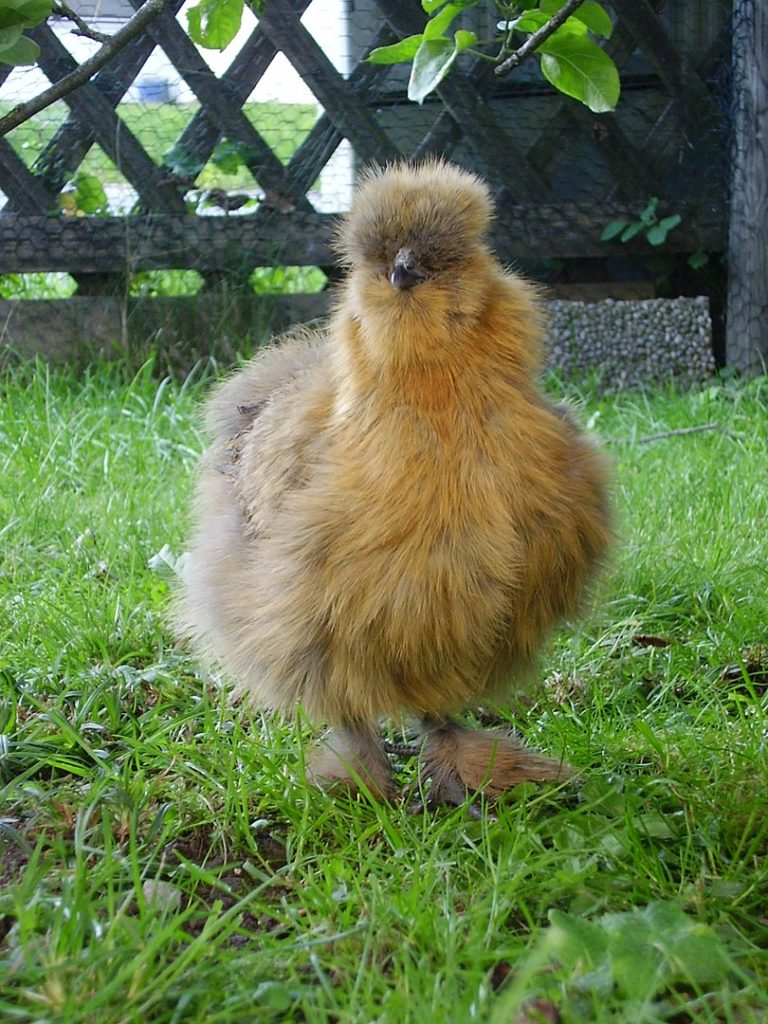
Personality
Silkies are remarkably friendly, universally recognized for their calm dispositions. They get along well with other chickens and can easily be raised in confinement.
If you have children, a Silkie chicken is one to consider, because it will get along well with children of all dispositions.
In fact, these birds are often raised as pets. They love to be pet and given lots of attention.
Broodiness
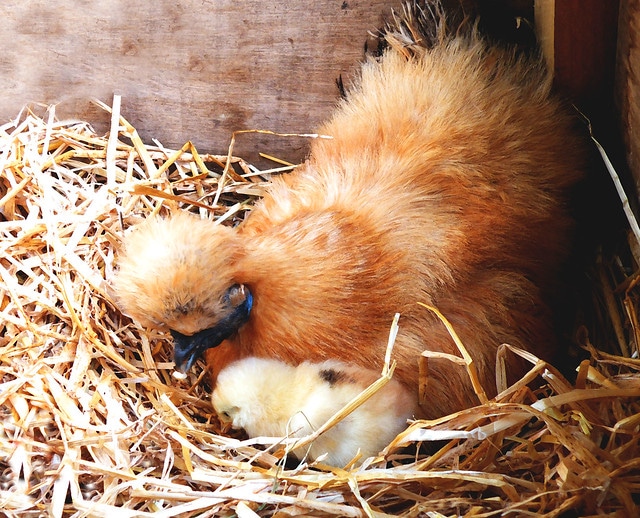
Silkie chickens are famous for their tendency to go broody.
In fact, although many breeders have selectively bred this broodiness out of other chicken breeds in order to maximize egg production, Silkies have been raised exclusively for this characteristic.
Because Silkies are excellent mothers, they are often raised to rear the offspring of other birds, including ducks, geese, and other chicken breeds.
Silkie chickens will go broody several times in one season, often spending several months of the year sitting on a nest of eggs.
After the eggs hatch, Silkie mothers are regarded as being attentive mothers, caring for their young long after they have grown.
If your SIlkie chicken goes broody, the easiest way to deal with this is to simply allow her to do so.
If you expect or need a lot of eggs, however, you can try to break her from this behavior by placing her in a wire-bottomed cage away from the flock.
Interactions & Temperament
Because Silkie chickens are so docile and friendly, this, unfortunately, leads to them being bullied frequently by other breeds.
It may be best to avoid keeping a Silkie chicken in a mixed flock, as this can cause some dominance issues.
These pets are docile and friendly and are more than happy to live in confinement. If you want to keep them in a large flock, keep them with chickens of the same species or breeds with a similar temperament.
Health and Wellbeing
You need to be careful about keeping your Silkie chicken in an aggressive flock.
For reasons already mentioned, a Silkie chicken will not fight back if it enters into a spat, and the soft spot at the top of its head makes it vulnerable to attacks.
In addition, Silkies have notably poor eyesight compared to most other breeds.
Because their feathery crests and facial feathers can grow to obscure their eyes, you may need to take some extra care to help your chickens see better.
Luckily, Silkies are easy to handle and manage, so it won’t take a lot of effort on your part to catch them.
As a breeder or a buyer of a Silkie chicken, you can lightly pluck the feathers away from the Silkie’s face to help it see better.
You can also pint he crest back using a hair or zip tie. If you are gentle, neither of these behaviors will harm the feathers of the bird.
Just make sure you are extremely careful about doing this if you plan on entering your chicken into a competitive show, as the plumage needs to be in tip-top shape.
Because the feathers of a Silkie extend all the way down to its feet, you need to be careful if you are keeping your flock in a wet or cold area.
Silkies are good about cleaning their own feet feathers, as they are with the rest of their feathers, but if you keep them in a muddy pen they may have a hard time staying dry. This can lead to some health issues.
Make sure you keep their living area clean at all times and also provide a dry roost for sleeping.
In addition, because the feathers on a Silkie chicken are not like those of other chickens and are more similar to a down material, these birds don’t do well in wet climates.
Their feathers are not waterproof, so you need to provide them with ample shelter during rainy periods.
The same rule applies to snow – although this breed can withstand the cold, wet precipitation of any kind is a major problem.
Ideal Living Conditions for Silkie Chickens
Silkies don’t fly well, so you don’t need to worry about building an abnormally tall fence. You can easily keep them in a chicken run or a backyard with a low fence.
This can prove to be an issue with predators, however, as Silkies really fall instead of fly and may have a hard time getting away from a potential attacker.
Therefore, you should provide a fully enclosed run that protects your birds from predators but also gives them plenty of space to run about.
They prefer perches that are low and close to the ground so that it is easier for them to hop up without injuring themselves.
Each Silkie will need about 10 square feet of run area and four square feet inside the chicken coop.
Providing your Silkie chickens with more space is definitely advised, as too little room can cause the birds to pick on each other.
They often burrow on the floor instead of perching on a roost, so you’ll want to give them extra space for this, too.
If they don’t have enough space to burrow close together, this can lead to suffocation and other potentially deadly problems.
If you must pick up or handle your SIlkie chicken, you should set them down carefully on the ground afterward.
Dropping them from a considerable height, as you might do with other chickens, can cause serious injury.
Silkies also like to be given lots of dust to bathe in. All chickens produce dust as they grow out their feathers, with the shafts flaking off as the feathers grow out.
This is particularly common in the spring months, but can also occur as a molt in the fall.
When your Silkie chickens molt, they will produce an exceptional amount of dust. Giving them lots of space to clean themselves can help reduce the amount of debris they produce.
Silkies thrive in captivity, but they do best when they are given some time outdoors. This will allow them to soak up the sun and nibble on grass and bugs.
The Silkie breed is fairly resistant to the cold but are very sensitive to high temperatures. Make sure they have plenty of cold water and shade when the mercury rises.
If the weather is above 100 degrees, you may need to provide a fan or some other type of cooling system in your chicken coop.
Silkie Chicken Yields (Eggs & Meat)
Egg and meat yields are a few of the main reasons that people keep chickens (although they also make great pets).
This section will help you understand what kind of yields you should expect to see from Silkie chickens.
Meat
Did you know that the meat of Silkie chickens is considered a delicacy in some parts of Asia?
This is because the meat has a richer, gamier flavor than the meat of other chicken breeds, and it is also a little bit darker.
As a result, it is used in many traditional Asian dishes such as in curries, Chinese soup, braising recipes, broths, and more.
It is even believed to strengthen the muscles and bolster the immune system.
While this was largely regarded as folklore for many years, the Ministry of Education at Nanchang University recently conducted a study that measured the quantities of naturally-occurring peptides in this breed as compared to other popular breeds of chicken.
Silkie meat was found to contain twice the amount of these peptides as meat from the common Plymouth Rock.
The takeaway?
Silkie meat is really good for you!
Eggs
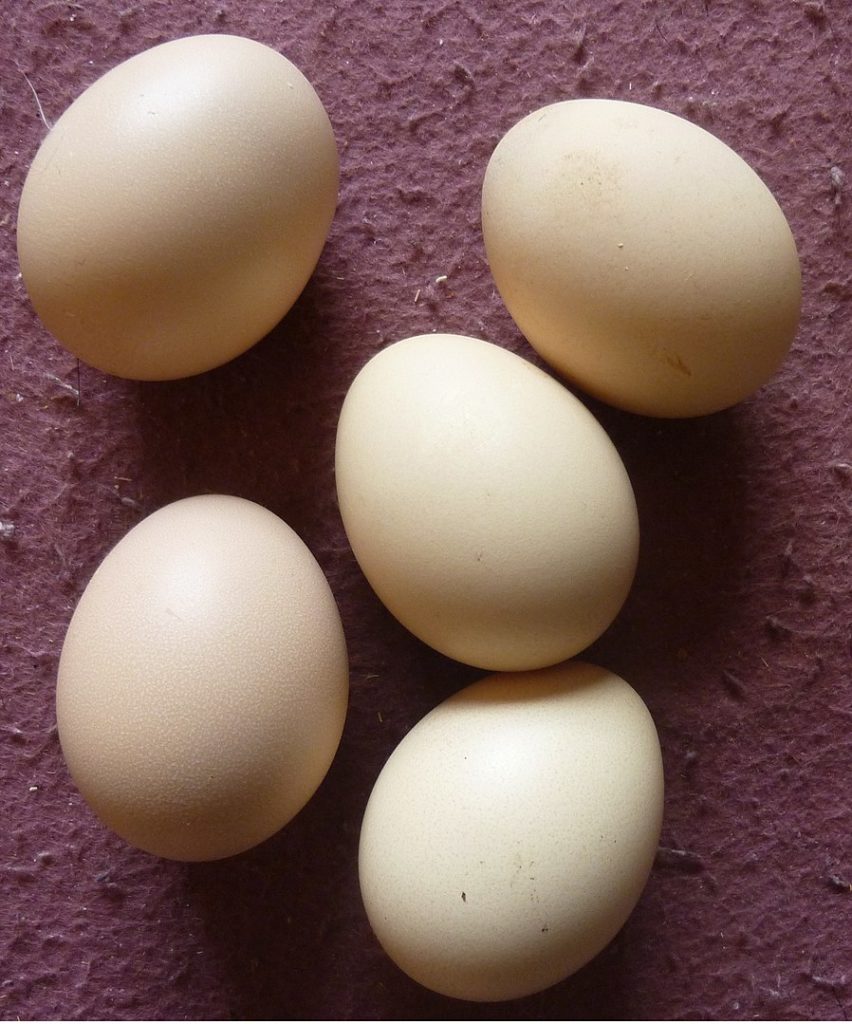
Silkie chickens lay eggs a normal amount each year. These are a light cream color, with each Silkie hen laying around 100 to 150 eggs per year.
Unfortunately, although Silkies have the potential to lay an exceptional amount of eggs, their laying season is often cut short by their tendency to go broody.
The exact amount of eggs you receive from your SIlkie chicken will vary depending on the conditions in which it is living, as well as on the individual bird.
Some Silkies will lay an egg each day of the year, while others might only lay once a week.
Therefore, it’s not wise to raise Silkies solely for egg production, as you will likely be disappointed. There are plenty of other great egg layers to choose from.
However, if you want to breed Silkies, you can introduce a Silkie rooster to the enclosure to get fertilized eggs.
Benefits of Raising Silkie Chickens
There are several benefits to raising Silkie chickens that make them a superior choice when compared to other kinds of birds.
- Friendliness: These birds are some of the most gentle, loving creatures you will find. They are also an excellent choice for keeping around children!
- Appearance: These chickens have gorgeous fluffy coats that make them the star of the poultry competition. They’re also incredibly soft to pet.
- Ability to Domesticate: Many people keep Silkie chickens indoors – you could even keep one of these chickens in an apartment! They are docile and love human company.
- Broodiness: Silkies are one of the best breeds at hatching their own eggs, as well as the eggs of other poultry.
- Ability to Withstand Confinement: If you don’t have the means to allow your chickens to free range at all times, the Silkie chicken is a good choice. These birds can be kept in a chicken coop or small run with minimal ill effects.
- Excellent for the Garden: Silkie chickens are not destructive and love to roam around in the garden when given the chance. This will allow them ample access to the worms, insects, and weeds growing in your plot.
- No Need for Wing Clipping: Because these chickens can’t fly very high, you won’t need to worry about clipping their wings or keeping them enclosed with tall fences.
Challenges of Raising Silkies
While there are many benefits associated with raising Silkie chickens, there are also some challenges to be aware of.
You should avoid raising Silkies if you live somewhere that is particularly hot, or if the run in which you will raise your Silkies is cold, muddy, or wet.
In addition to those concerns, these are some of the biggest challenges involved in raising SIlkies:
- Inability to Withstand Heat: Because these chickens are covered in such a dense mat of feathers, they do not perform well in extreme heat.
- Poor Egg and Meat Production: Silkie chickens are primarily raised as pet or show species. They are small, so they don’t produce remarkable amounts of meat for the amount of food you must feed them. Their egg production is often cut short by their broodiness.
- Poor Position in the Pecking Order: Because they are so calm and trusting, Silkie chickens are often bullied by other members of the flock.
- Prone to Predators: These chickens don’t run quickly, have poor vision, and can’t fly or jump very well. Therefore, you will need exceptionally safe housing if you choose to raise them.
Baby Silkies: Raising Silkies as Chicks
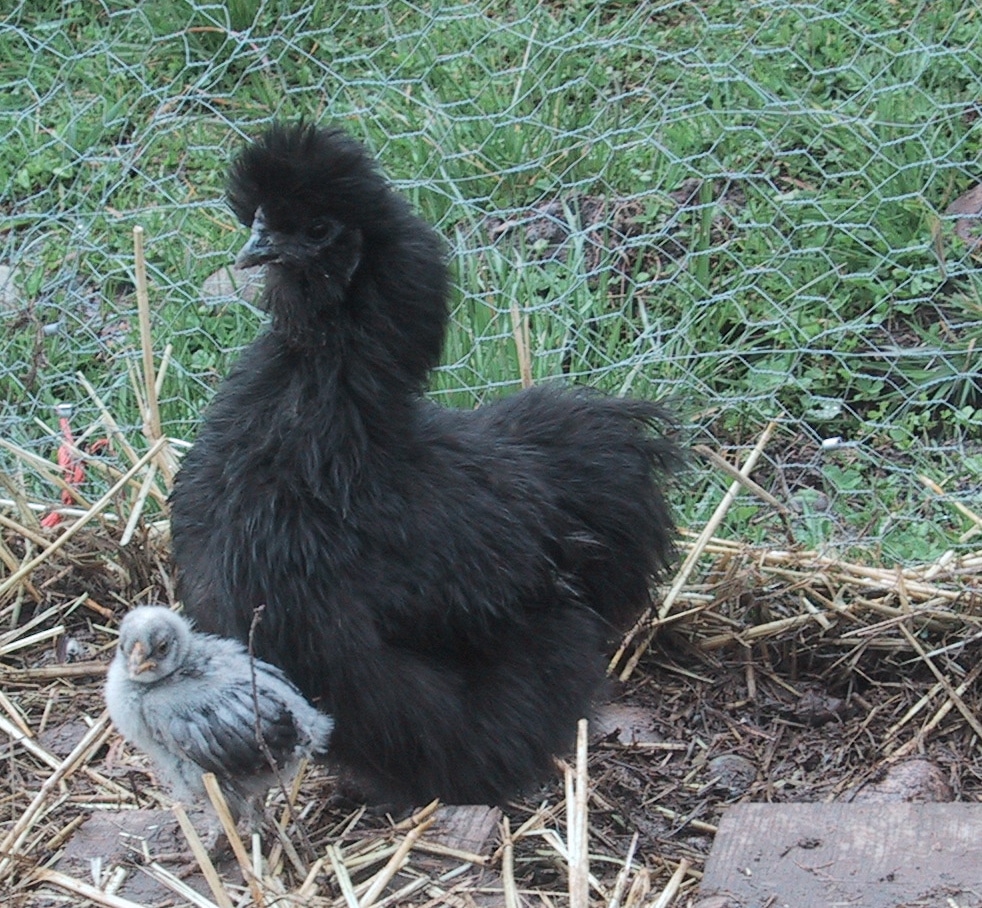
Silkie eggs take about 21 days to hatch.
In some cases, they may take a little bit longer if you are using a broody hen or even an unreliable incubatorto hatch your eggs.
These birds hatch quite slowly, pecking at the inside of the eggshell with a small attachment on their beaks called an egg-tooth. This tooth falls off a few days after hatching.
If you are hatching your own SIlkie chicks, leave them in the incubator until they have fully dried.
They will be nice and fluffy by the time they are ready to be moved. Then, you can move them to a brooder that is well-stocked with water, chick feed, and a good heat lamp.
Silkies should b kept in the new box for about 6 weeks.
It may be tempting to move your Silkie chicks to an outdoor pen sooner since they are covered in such dense feathers, but you really need to wait to make sure they have enough feathers to handle colder temperatures.
You may have to wait until spring has really set in to move your birds.
Silkies reach full size in about three or four months.
During this growth period, they will put on multiple sequences of new feathers, shedding their old ones as they do so.
You may find that they leave a lot of dust behind as they put on new growth.
It is virtually impossible to identify the differences between male and female Silkies until they reach about six or seven months of age. So, if you buy them as chicks, you may get a Silkie rooster even if you’re only looking for hens.
As chicks, these birds cost between $3 and $10 per bird. However, adults can cost anywhere from $15 to $50.
There aren’t many dissimilarities between the genders, and you usually won’t be able to tell them apart until the silkie hens start laying eggs or the roosters start crowing.
Frequently Asked Questions
Are Silkie chickens the best breed for you? Before you decide, let’s look at questions new chicken keepers commonly wonder.
Do Silkie Chickens Like Being Held?
Yes, most Silkies enjoy because held. They’re kind, gentle birds that are more tolerant of being handled than other breeds. Their easygoing nature is great because they have fuzzy feathers that are soft to the touch.
Do Silkies Need Coop Heaters?
No, unlike other breeds, Silkie chickens don’t need coop heaters. Their fuzzy plumage keeps them warm in the winter, so extra heat isn’t necessary. However, their feathers aren’t waterproof, so make sure their coop stays dry, especially when it’s cold outside.
Do You Need to Bathe Silkie Chickens?
You can bathe your Silkies if you’d like, but it’s not the most effective way to keep them clean. If they take a bath with water, they must be completely dry before returning to the coop. Since their feathers are different than regular chicken feathers, it’s harder to dry them off. So, most keepers rely on dust baths instead.
Is the Silkie Chicken Right For You?
If you’re interested in raising a Silkie chicken, know that there isn’t much you need to do in order to keep them happy and healthy.
Provide them with plenty of nutritious food and clean, fresh water.
Give them a safe enclosure so that they can get out of the sun and escape from predators, and provide lots of dirt in which to scratch.
Occasionally, you may need to lightly groom your SIlkie chicken to make sure he or she can see and get around without any issues.
Otherwise, this chicken breed is one of the eaisest and most enjoyable you can raise.
You may get a few curious glances from your neighbors – you may even have some people who don’t believe your Silkies are actually chickens! – but believe us, raising one of these quirky birds is absolutely worth it.
